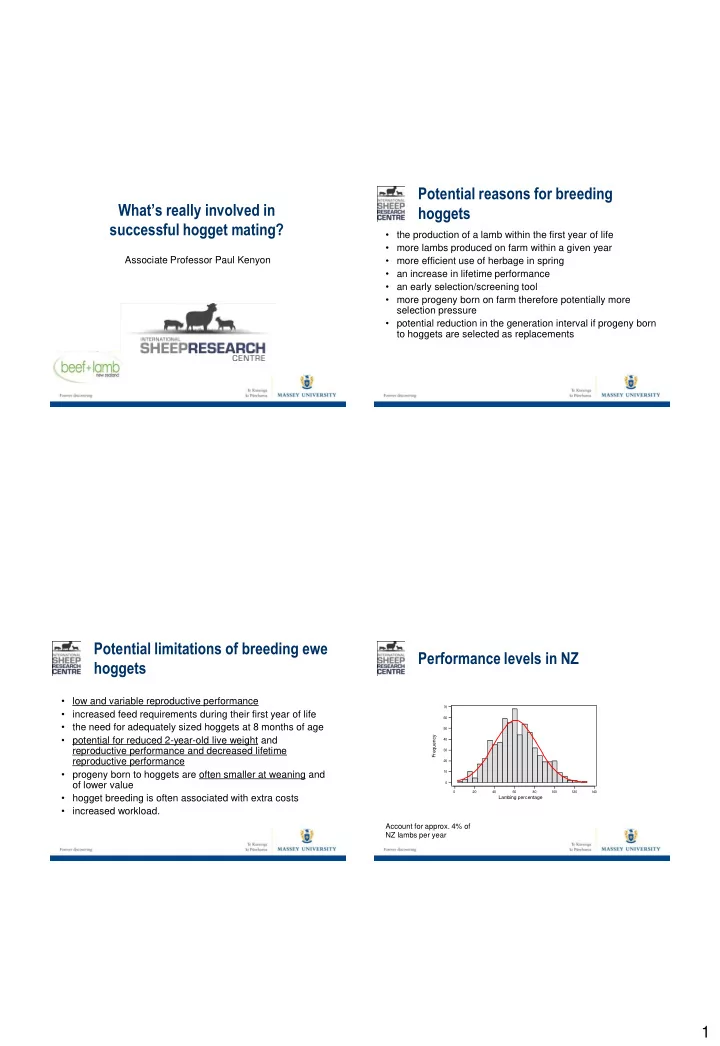

Potential reasons for breeding What’s really involved in hoggets successful hogget mating? • the production of a lamb within the first year of life • more lambs produced on farm within a given year Associate Professor Paul Kenyon • more efficient use of herbage in spring • an increase in lifetime performance • an early selection/screening tool • more progeny born on farm therefore potentially more selection pressure • potential reduction in the generation interval if progeny born to hoggets are selected as replacements Potential limitations of breeding ewe Performance levels in NZ hoggets • low and variable reproductive performance 70 • increased feed requirements during their first year of life 60 • the need for adequately sized hoggets at 8 months of age 50 • potential for reduced 2-year-old live weight and Frequency 40 reproductive performance and decreased lifetime 30 reproductive performance 20 • progeny born to hoggets are often smaller at weaning and 10 of lower value 0 0 20 40 60 80 100 120 140 • hogget breeding is often associated with extra costs Lambing percentage • increased workload. Account for approx. 4% of NZ lambs per year 1
Pre-breeding management • Vaccination against abortive organisms Management plan to maximise performance from hogget breeding • Shearing • Do not shear close to breeding Pre-breeding management Pre-breeding management • Breeds • Live weight at breeding – from a reproductive perspective – Yes there are breed differences – but not every farmer can change or is willing to change – Ideally should be a minimum of 38 – 40 kg – Each extra 1 kg above 36 kg is worth an extra 2% of – Finn/East Fr. and their composites highest performers lambs – Coopworth the highest performer of the traditional • although recent data suggests no further reproductive breeds benefit above 45 kg • Target condition score 2.5 2
Pre-breeding management Management during breeding • Ewe lambs are shy breeders – so ram to ewe hogget ratio • Use teasers is important during the breeding period – Expose hoggets to teasers for 17 days prior to planned – 1:50 to 1:75 start of breeding • Ideal ratio 1:75 • Avoid the use of ram lambs during the breeding period – Recent data suggests teasing can be used in late – Unless ratios are low March/early April to allow for breeding of ewe hoggets in April • Mature rams can be re-used in the same season Management during breeding • Limit the length of the breeding period to avoid late lambing hoggets Management in pregnancy • If using teasers breed for 26 days (9 +17) 3
Management in pregnancy The below figure indicates that in late pregnancy fetal growth is the major driver of weight change which explains why a change in weight of the hogget needs to occur in early pregnancy – To maximise the weight of the ewe lamb and her offspring at weaning she needs to be gaining 150 g/d in total live weight throughout pregnancy • this live weight gain needs to start during the breeding period – gains in early pregnancy have the biggest impact • this either requires a reduction in other classes of stock or an increase in alternative feed sources Management in pregnancy Modelling of weight response per kg • Mid pregnancy shearing can be used with hoggets Time point W. Wgt hogget B.Wgt lamb W.Wgt lamb Mating 1.3 kg 16g 71g – Although a survival response in the lambs is dependant on the weather at lambing. Day 50 of preg. 1.1 kg 9g 37g • Trial data does not suggest an increase in dystocia Day 100 of 0.7 kg 5g 23g preg. Day 147 of 0.5 kg 4g 16g preg. 4
Management in pregnancy • Management during/prior to lambing Management in lactation – paddocks should ideally provide shelter – herbage intake minimum covers of 1200 kgDM/ha – advantages from separating multiple- and single-bearing ewe lambs Management in lactation • Ensure pasture covers do not get below 1200 kg DM/ha Potential lifetime effects • Consider weaning early to allow young mother more time to recover – this can benefit the young dam and if done correctly will not impact on weaned lamb growth 5
Summary points about lifetime effects Summary points about lifetime effects • Our data matches the work undertaken in the past both in • Reproductive performance (two-tooth to five years) did not New Zealand and overseas differ overall • What this shows is…. • But given that they lambed as a hogget their lifetime reproductive performance was higher (just over 1 extra – yes there can be a check as a two-tooth fetus) – but it is not permanent and it does not negatively affect their lifetime performance (in fact it has a positive effect) • Ewe wastage did not differ between those bred as a hogget or not over the 5 year period Does being born to a hogget impact on Conclusion the progenies performance? • Hogget breeding has the potential to improve on farm • In single born progeny it appears there is no real effect productivity – a slight suggestion that they may carry more internal fat • Breeding a hogget does not negatively affect her lifetime performance • In twins the data we have to date suggests that those born – in fact it has a positive effect to hoggets may be stunted in terms of growth (to at least 18 • The are no magic bullets for getting hogget breeding months of age) correct – but getting the feeding and live weights correct are the major drivers of success 6
Recommend
More recommend